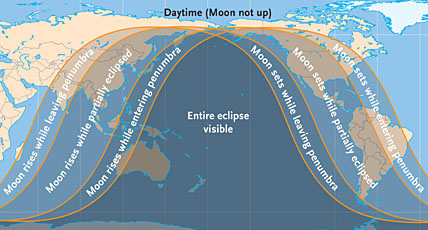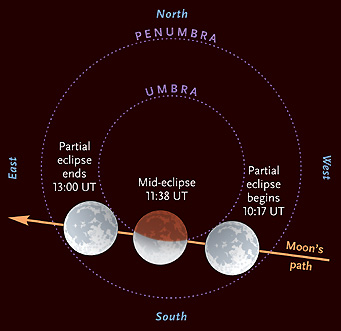
Find your location to see whether the Moon will rise or set during any phase of the eclipse for you. Because an eclipsed Moon is always full, it sets almost at the same time the Sun rises on the opposite horizon.
Sky & Telescope illustration
It's been more than two years (February 2008) since North Americans got a chance to see the Moon engulfed by Earth's deep shadow. But that long dry spell is about to end, at least partly.
On the morning of Saturday, June 26th, observers in the western half of the United States can watch a partial eclipse of the Moon before or during dawn. The full Moon, in Sagittarius, will be sinking low in the southwest and will set around sunrise.
The farther west you are, the better your prospects. The entire eclipse happens in a dark sky over much of the Pacific Ocean, including Hawaii. The West Coast sees the eclipse's final stages low in twilight. In the Mountain and part of the Central time zones, the partial eclipse will still be under way at the time of moonset and sunrise. East of there the Moon sets before the partial eclipse even begins. You can gauge the Moon's visibility from your location by comparing the times in this table with the time of local moonset:
| Partial Lunar Eclipse, June 26, 2010 | ||||
| Eclipse event | CDT | MDT | PDT | HST |
| Penumbra first visible? | 4:30 a.m. | 3:30 a.m. | 2:30 a.m. | 11:30 p.m. |
| Partial eclipse begins | 5:17 a.m. | 4:17 a.m. | 3:17 a.m. | 12:17 a.m. |
| Mid-eclipse | — | 5:38 a.m. | 4:38 a.m. | 1:38 a.m. |
| Partial eclipse ends | — | — | 6:00 a.m. | 3:00 a.m. |
| Penumbra last vibisle? | — | — | — | 3:45 a.m. |

The northern half of the Moon skims through Earth”™s umbra (dark shadow core) during June 26th's eclipse. Less noticeable will be the first and last stages of the eclipse, when the Moon is in the penumbra:, the shadow”™s pale outer fringe. Click on the image for a
Sky & Telescope illustration
At the deepest stage of the eclipse, the dark red-brown umbra of Earth's shadow will cover the northern 54% of the Moon's diameter, as shown in the diagram at right.
The penumbral phases of the eclipse occur when the moon is only within the penumbra, or pale outer fringe, of Earth's shadow. The weak penumbral shading is detectable only within about 45 minutes of the partial eclipse's beginning or end.
This lunar eclipse is a warmup for the big one coming in six months. Late on the night of December 20-21, 2010, the Moon will be totally eclipsed high in a dark sky for all of North America.
Note: There was an error in this article when it first appeared in the June issue of Sky & Telescope. The date was correctly printed as June 26th, but the day was mistakenly identified as Sunday. The eclipse actually happens on Saturday morning.
 0
0
Comments
You must be logged in to post a comment.